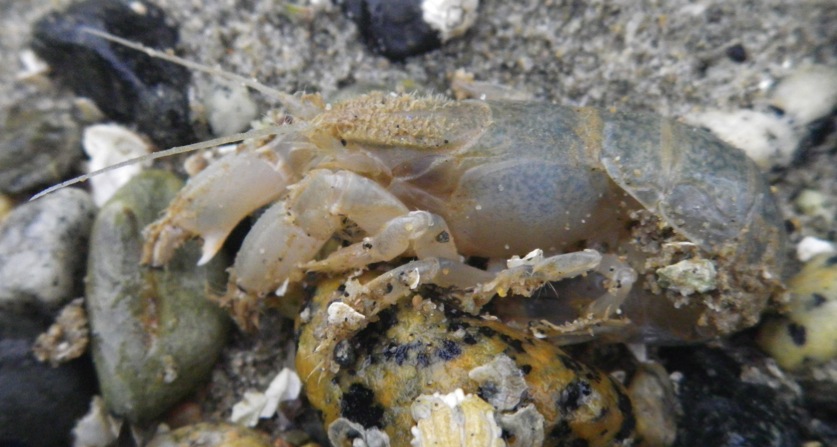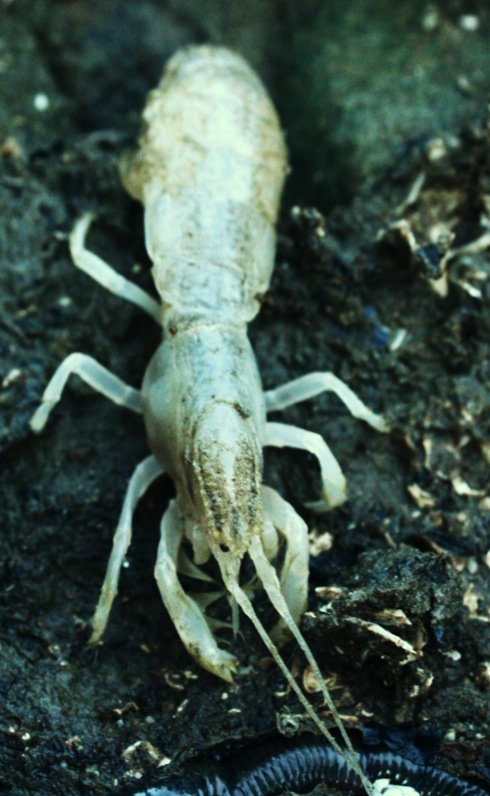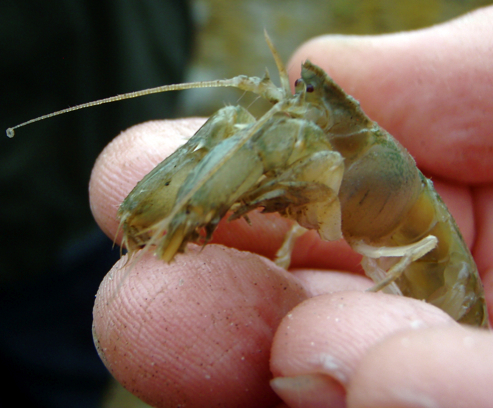Blue mud shrimp, marine crayfish • Upogebia pugettensis
Blue mud shrimp found in the muddy intertidal areas of Calvert Island beaches. Photos by Yuhei Iida (lower left), Teegan Bennington (two lower right), and Caylie Boos (top).
Identification
The blue mud shrimp is a distinctive-looking, relatively large shrimp species. It grows to 15 cm long, and has a tan-grey, bluish-grey, or white body. Its front legs are larger than the rest, and are modified with small claws. Its main claws are equal in size. Its legs and claws are hairy, and it has a large tail fan which appears similar to that of a lobster and which can curl under the body.
Habitat & Range
The blue mud shrimp lives in the lower intertidal zone, in a permanent U- or Y-shaped mud-sand and mud-gravel burrow. Its range stretches from southern Alaska to Baja California.
Intriguing Info
If an adult blue mud shrimp is removed from its burrow, it apparently is unable to build a new one.
This species often has a parasitic bivalve called a mud shrimp clam (Psuedopythina rugifera) attached to its underside.
The blue mud shrimp can be a pest to oyster growers, as the mud the shrimp displaces while burrowing can smother young oysters in certain types of oyster beds.
The blue mud shrimp is a distinctive-looking, relatively large shrimp species. It grows to 15 cm long, and has a tan-grey, bluish-grey, or white body. Its front legs are larger than the rest, and are modified with small claws. Its main claws are equal in size. Its legs and claws are hairy, and it has a large tail fan which appears similar to that of a lobster and which can curl under the body.
Habitat & Range
The blue mud shrimp lives in the lower intertidal zone, in a permanent U- or Y-shaped mud-sand and mud-gravel burrow. Its range stretches from southern Alaska to Baja California.
Intriguing Info
If an adult blue mud shrimp is removed from its burrow, it apparently is unable to build a new one.
This species often has a parasitic bivalve called a mud shrimp clam (Psuedopythina rugifera) attached to its underside.
The blue mud shrimp can be a pest to oyster growers, as the mud the shrimp displaces while burrowing can smother young oysters in certain types of oyster beds.
References
Cowles, D. (2005). Upogebia pugettensis (Dana, 1852). Invertebrates of the Salish Sea. Rosario Beach Marine Laboratory. Accessed 15/09/2013.
Harbo, R. M. (1999). Whelks to whales: Coastal marine life of the Pacific Northwest. Madeira Park, BC: Harbour Publishing. P. 66.
Hart, J. Upogebia pugettensis (Dana, 1852). In Klinkenberg, Brian. (Editor) 2012. E-Fauna BC: Electronic Atlas of the Fauna of British Columbia. Lab for Advanced Spatial Analysis, Department of Geography, University of British Columbia, Vancouver. Accessed 15/09/2013.
Authors and editors of page
Kelly Fretwell and Brian Starzomski (2013).
Cowles, D. (2005). Upogebia pugettensis (Dana, 1852). Invertebrates of the Salish Sea. Rosario Beach Marine Laboratory. Accessed 15/09/2013.
Harbo, R. M. (1999). Whelks to whales: Coastal marine life of the Pacific Northwest. Madeira Park, BC: Harbour Publishing. P. 66.
Hart, J. Upogebia pugettensis (Dana, 1852). In Klinkenberg, Brian. (Editor) 2012. E-Fauna BC: Electronic Atlas of the Fauna of British Columbia. Lab for Advanced Spatial Analysis, Department of Geography, University of British Columbia, Vancouver. Accessed 15/09/2013.
Authors and editors of page
Kelly Fretwell and Brian Starzomski (2013).







